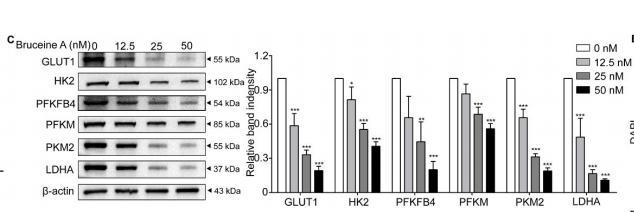| 产品: | PFKM 抗体 |
| 货号: | AF7562 |
| 描述: | Rabbit polyclonal antibody to PFKM |
| 应用: | WB |
| 文献验证: | WB |
| 反应: | Human, Mouse, Rat |
| 预测: | Pig, Bovine, Horse, Sheep, Rabbit, Dog, Chicken, Xenopus |
| 分子量: | 85kDa; 85kD(Calculated). |
| 蛋白号: | P08237 |
| RRID: | AB_2843926 |
产品描述
*The optimal dilutions should be determined by the end user.
*Tips:
WB: 适用于变性蛋白样本的免疫印迹检测. IHC: 适用于组织样本的石蜡(IHC-p)或冰冻(IHC-f)切片样本的免疫组化/荧光检测. IF/ICC: 适用于细胞样本的荧光检测. ELISA(peptide): 适用于抗原肽的ELISA检测.
引用格式: Affinity Biosciences Cat# AF7562, RRID:AB_2843926.
展开/折叠
6 Phosphofructokinase Muscle Type; 6-phosphofructokinase; 6-phosphofructokinase muscle type; EC 2.7.1.1; EC 2.7.1.11; GSD7; K6PF_HUMAN; MGC8699; muscle type; PFK, muscle type; PFK-A; PFKA; PFKL; PFKM; PFKP; PFKX; Phosphofructo 1 Kinase Isozyme A; Phosphofructo-1-kinase isozyme A; Phosphofructokinase 1; Phosphofructokinase M; Phosphofructokinase, muscle; Phosphofructokinase, muscle type; Phosphofructokinase, polypeptide X; Phosphofructokinase-M; Phosphohexokinase;
抗原和靶标
- P08237 PFKAM_HUMAN:
- Protein BLAST With
- NCBI/
- ExPASy/
- Uniprot
MTHEEHHAAKTLGIGKAIAVLTSGGDAQGMNAAVRAVVRVGIFTGARVFFVHEGYQGLVDGGDHIKEATWESVSMMLQLGGTVIGSARCKDFREREGRLRAAYNLVKRGITNLCVIGGDGSLTGADTFRSEWSDLLSDLQKAGKITDEEATKSSYLNIVGLVGSIDNDFCGTDMTIGTDSALHRIMEIVDAITTTAQSHQRTFVLEVMGRHCGYLALVTSLSCGADWVFIPECPPDDDWEEHLCRRLSETRTRGSRLNIIIVAEGAIDKNGKPITSEDIKNLVVKRLGYDTRVTVLGHVQRGGTPSAFDRILGSRMGVEAVMALLEGTPDTPACVVSLSGNQAVRLPLMECVQVTKDVTKAMDEKKFDEALKLRGRSFMNNWEVYKLLAHVRPPVSKSGSHTVAVMNVGAPAAGMNAAVRSTVRIGLIQGNRVLVVHDGFEGLAKGQIEEAGWSYVGGWTGQGGSKLGTKRTLPKKSFEQISANITKFNIQGLVIIGGFEAYTGGLELMEGRKQFDELCIPFVVIPATVSNNVPGSDFSVGADTALNTICTTCDRIKQSAAGTKRRVFIIETMGGYCGYLATMAGLAAGADAAYIFEEPFTIRDLQANVEHLVQKMKTTVKRGLVLRNEKCNENYTTDFIFNLYSEEGKGIFDSRKNVLGHMQQGGSPTPFDRNFATKMGAKAMNWMSGKIKESYRNGRIFANTPDSGCVLGMRKRALVFQPVAELKDQTDFEHRIPKEQWWLKLRPILKILAKYEIDLDTSDHAHLEHITRKRSGEAAV
种属预测
score>80的预测可信度较高,可尝试用于WB检测。*预测模型主要基于免疫原序列比对,结果仅作参考,不作为质保凭据。
High(score>80) Medium(80>score>50) Low(score<50) No confidence
研究背景
Catalyzes the phosphorylation of D-fructose 6-phosphate to fructose 1,6-bisphosphate by ATP, the first committing step of glycolysis.
GlcNAcylation decreases enzyme activity.
Cytoplasm.
Homo- and heterotetramers (By similarity). Phosphofructokinase (PFK) enzyme functions as a tetramer composed of different combinations of 3 types of subunits, called PFKM (where M stands for Muscle), PFKL (Liver) and PFKP (Platelet). The composition of the PFK tetramer differs according to the tissue type it is present in. In muscles, it is composed of 4 PFKM subunits (also called M4). In the liver, the predominant form is a tetramer of PFKL subunits (L4). In erythrocytes, both PFKM and PFKL subunits randomly tetramerize to form M4, L4 and other combinations (ML3, M2L2, M3L). The kinetic and regulatory properties of the tetrameric enzyme are dependent on the subunit composition, hence can vary across tissues (Probable). Interacts (via C-terminus) with HK1 (via N-terminal spermatogenic cell-specific region) (By similarity).
Belongs to the phosphofructokinase type A (PFKA) family. ATP-dependent PFK group I subfamily. Eukaryotic two domain clade 'E' sub-subfamily.
研究领域
· Environmental Information Processing > Signal transduction > AMPK signaling pathway. (View pathway)
· Genetic Information Processing > Folding, sorting and degradation > RNA degradation.
· Human Diseases > Cancers: Overview > Central carbon metabolism in cancer. (View pathway)
· Metabolism > Carbohydrate metabolism > Glycolysis / Gluconeogenesis.
· Metabolism > Carbohydrate metabolism > Pentose phosphate pathway.
· Metabolism > Carbohydrate metabolism > Fructose and mannose metabolism.
· Metabolism > Carbohydrate metabolism > Galactose metabolism.
· Metabolism > Global and overview maps > Metabolic pathways.
· Metabolism > Global and overview maps > Carbon metabolism.
· Metabolism > Global and overview maps > Biosynthesis of amino acids.
文献引用
Application: WB Species: human Sample: MIA PaCa-2 cells
Application: WB Species: Mouse Sample:
限制条款
产品的规格、报价、验证数据请以官网为准,官网链接:www.affbiotech.com | www.affbiotech.cn(简体中文)| www.affbiotech.jp(日本語)产品的数据信息为Affinity所有,未经授权不得收集Affinity官网数据或资料用于商业用途,对抄袭产品数据的行为我们将保留诉诸法律的权利。
产品相关数据会因产品批次、产品检测情况随时调整,如您已订购该产品,请以订购时随货说明书为准,否则请以官网内容为准,官网内容有改动时恕不另行通知。
Affinity保证所销售产品均经过严格质量检测。如您购买的商品在规定时间内出现问题需要售后时,请您在Affinity官方渠道提交售后申请。产品仅供科学研究使用。不用于诊断和治疗。
产品未经授权不得转售。
Affinity Biosciences将不会对在使用我们的产品时可能发生的专利侵权或其他侵权行为负责。Affinity Biosciences, Affinity Biosciences标志和所有其他商标所有权归Affinity Biosciences LTD.

